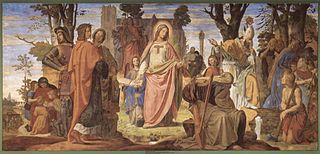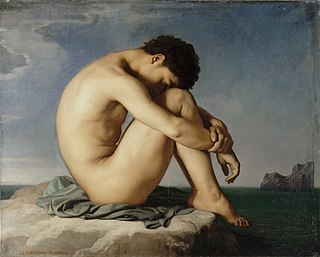 W
WAqueduct near Rome is an 1832 oil painting by Thomas Cole. It measures 44.5 in × 67.3 in and is the largest painting that Cole completed during his first visit to Italy in 1831–32.
 W
WThe Course of Empire is a series of five paintings created by Thomas Cole in the years 1833–1836. It is notable in part for reflecting popular American sentiments of the times, when many saw pastoralism as the ideal phase of human civilization, fearing that empire would lead to gluttony and inevitable decay. The theme of cycles is one that Cole returned to frequently, such as in his The Voyage of Life series. The Course of Empire comprises the following works: The Course of Empire – The Savage State; The Arcadian or Pastoral State; The Consummation of Empire; Destruction; and Desolation. All the paintings are oil on canvas, and all are 39.5 inches by 63.5 inches except The Consummation of Empire which is 51″ by 76″.
 W
WDie Einführung der Künste in Deutschland durch das Christentum (1834–1836) is a triptych by German artist Philipp Veit (1793-1877), which allegorically represents the introduction of the arts into Germany through Christianity. The central panel has a woman representing Christianity, surrounded by personifications of the arts. A group of people on the right are listening to a sermon by Saint Boniface, portrayed as the missionizer of Germany. A sad and dark figure on the front, holding a small harp, stands for paganism: his era has come to an end. The work is a fresco, transferred onto fabric.
 W
WThe Poem of the Soul is a series of oil on canvas paintings by Louis Janmot, produced between 1835 and 1881 and totalling eighteen paintings and sixteen charcoal drawings, all inspired by a 2800 verse poem by Janmot himself. The first works in the series were exhibited at the 1855 Exposition Universelle. The series tells of a soul's life on earth, incarnated in a young man, accompanied by his female double. His companion then disappears and he spends the rest of his life alone, as did the artist. The series is now in the Museum of Fine Arts of Lyon.
 W
WStudy is a painting by Hippolyte Flandrin executed between 1835 and 1836. Flandrin had won France's Prix de Rome in 1832, a bursary which provided the winner with a trip to Rome to concentrate on their vocation. There, Flandrin produced this study, which he sent back to Paris in 1837, in fulfillment of the bursary's requirements for the student to submit works in the tradition of various genres. In 1857, Napoleon III purchased the painting, which is now in the collection of Paris's Louvre.
 W
WThe Submission of Prince Dipo Negoro to General De Kock is an oil painting on canvas painted by Nicolaas Pieneman between 1830 and 1835. It depicts, from a victorious Dutch colonial perspective, the capture of Prince Diponegoro in 1830, which signaled the end of the Java War (1825–1830).
 W
WSundai, Edo is a woodblock print by the Japanese ukiyo-e artist Hokusai. It was produced as the fifth print in the series Thirty-six Views of Mount Fuji from c. 1830 to 1832 in the late Edo period.